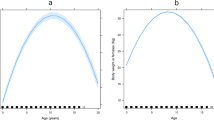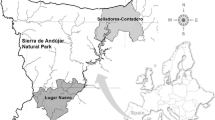Summary
Most life-history theory assumes that short-term variation in an organism's environment does not affect the survivorships and fecundities of the organisms. This assumption is rarely met. Here we investigate the population and evolutionary biology of red deer,Cervus elephas, to see if relaxation of this assumption is likely to make significant differences to the predicted evolutionary biology of this species. To do this we used 21 years of data from a population of deer on Rum, Western Isles, Scotland. Population growth rates in a stochastic environment were estimated using Tuljapurkar's small noise approximation, confirmed by bootstrap simulation. Numerical differentiation was used to see if the selection pressures (i.e. sensitivities of population growth rate to changes in the vital rates) differ between the stochastic and deterministic cases. The data also allow the costs of reproduction to be estimated. These costs, incorporated as trade-offs into the sensitivity analysis, allow investigation of evolutionary benefits of different life-history tactics. Environmentally induced stochastic variation in the red deer vital rates causes a slight reduction (≃ 1%) in the predicted population growth rate and has little impact on the estimated selection pressures on the deer's life-history. We thus conclude that, even though density-independent stochastic effects on the population are marked, the deer's fitness is not markedly affected by these and they are adapted to the average conditions they experience. However, the selected life-history is sensitive to the trade-offs between current fecundity, survivorship and future fecundity and it is likely that the environmental variance will affect these trade-offs and, thus, affect the life-history favoured by selection. We also show that the current average life-history is non-optimal and suggest this is a result of selection pressures exerted by culling and predation, now much reduced. As the use of stochastic or deterministic methods provide similar estimates in this case, the use of the latter is justified. Thus,r (the annual per capita rate of population growth) is an appropriate measure of fitness in a population with stochastic numerical fluctuations. In a population of constant size lifetime reproductive success is the obvious measure of fitness to use.
Similar content being viewed by others
References
Albon, S.D. and Clutton-Brock, T.H. (1988) Climate and the population dynamics of red deer in Scotland. InEcological Change in the Uplands (M.B. Usher and D.B.A. Thompson, eds) pp. 93–107. Blackwell Scientific Publications, Oxford.
Albon, S.D., Clutton-Brock, T.H. and Guinness, F.E. (1987) Early development and population dynamics in red deer. II. Density-independent effects and cohort variation.J. Anim. Ecol. 56 69–81.
Albon, S.D., Clutton-Brock, T.H. and Langvatn, R. (1992) Cohort variation in reproduction and survival: implications for population demography. InThe biology of deer (R.D. Brown, ed.), pp. 15–21. Springer-Verlag, Berlin.
Benton, T.G. and Grant, A. (in press) How to keep fit in the real world: elasticity analysis and selection pressure on life-histories in a variable environment.Am. Nat.
Brown, D., Alexander, N.D. E, Marrs, R.W. and Albon, S.D. (1993) Structured accounting of the variance of demographic change.J. Anim. Ecol. 62 490–502.
Caswell, H. (1989)Matrix Population Models. Sinauer Associates, Inc., Sunderland, MA.
Charlesworth, B.C. (1980)Evolution in Age-structured Populations. Cambridge University Press, Cambridge.
Clutton-Brock, T.H. (ed.) (1988)Reproductive Success. University of Chicago Press, Chicago.
Clutton-Brock, T.H. and Albon, S.D. (1989)Red Deer in the Highlands. BSP Professional Books, Oxford.
Clutton-Brock, T.H., Guinness, F.E. and Albon, S.D. (1982)Red Deer: Behaviour and Ecology of Two Sexes. University of Chicago Press, Chicago.
Diggle, P.J. (1990)Time Series: A Biostatistical Introduction. Clarendon Press, Oxford.
Fox, G.A. (1993) Life-history evolution and demographic stochasticity.Evol. Ecol. 7 1–14.
Giske, J., Aksnes, D.L. and Førland, B. (1993) Variable generation times and Darwinian fitness measures.Evol. Ecol. 7 223–39.
Kazwecki, T.J. and Stearns, S.C. (1993) The evolution of life-histories in spatially heterogeneous environments: optimal reaction norms revisited.Evol. Ecol. 7 155–74.
Kozlowski, J. (1993) Measuring fitness in life-history studies.Trends Ecol. Evol. 8 84–5.
Lande, R. (1982) A quantitative genetic theory of life-history evolution.Ecology 63 607–15.
Metz, J.A.J., Nisbet, R.M. and Geritz, S.A.H. (1992) How should we define fitness for general ecological scenarios?Trends Ecol. Evol. 7 198–202.
Murphy, G.I. (1968) Pattern in life-history and the environment.Am. Nat. 102 391–403.
Orzack, S.H. (1985) Population dynamics in variable environments. V. The genetics of homeostasis revisited.Am. Nat. 125 550–72.
Orzack, S.H. and Tuljapurkar, S.D. (1989) Population dynamics in variable environments VII. The demography and evolution of iteroparity.Am. Nat. 133 901–23.
Read, A.J. and Harvey, P.H. (1989) Life-history differences among the eutherian radiations.J. Zoo, London 219 329–53.
Ripley, B.D. (1987)Stochastic Simulation. John Wiley and Sons, New York.
Schaffer, W.M. (1974) Optimal reproductive effort in fluctuating environments.Am. Nat. 108 783–90.
Sibly, R.M. and Calow, P. (1986) Why breeding earlier is always worthwhile.J. Theor. Biol. 123 311–19.
Sibly, R.M. and Curnow, R.N. (1993) An allelocentric view of life-history evolution.J. Theor. Biol. 160 533–46.
Slade, N.A. and Levenson, H. (1984) The effect of skewed distributions of vital statistics on growth of agestructured populations.Theor. Pop. Biol. 26 361–6.
Tuljapurkar, S.D. (1982) Population dynamics in variable environments. III. Evolutionary dynamics ofr selection.Theor. Pop. Biol. 21 141–65.
Tuljapurkar, S.D. (1989) An uncertain life: demography in random environments.Theor. Pop. Biol. 35 227–94.
Tuljapurkar, S.D. (1990a)Population Dynamics in Variable Environments. Lecture Notes in Biomathematics85. Springer—Verlag, New York.
Tuljapurkar, S.D. (1990b) Delayed reproduction and fitness in variable environments.Proc. Nat Acad. Sci. USA 87 1139–43.
Tuljapurkar, S.D. and Orzack, S.H. (1980) Population dynamics in variable environments I. Long-run growth rates and extinction.Theor. Pop. Biol. 18 314–42.
Van Sickle, J. (1990) Dynamics of African ungulate populations with fluctuating, density-independent calf survival.Theor. Pop. Biol. 37 424–37.
Author information
Authors and Affiliations
Rights and permissions
About this article
Cite this article
Benton, T.G., Grant, A. & Clutton-Brock, T.H. Does environmental stochasticity matter? Analysis of red deer life-histories on Rum. Evol Ecol 9, 559–574 (1995). https://doi.org/10.1007/BF01237655
Issue Date:
DOI: https://doi.org/10.1007/BF01237655




